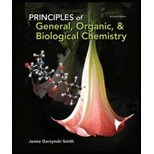
Principles of General Organic & Biological Chemistry
2nd Edition
ISBN: 9780077633721
Author: Janice Smith
Publisher: Mcgraw-hill Higher Education (us)
expand_more
expand_more
format_list_bulleted
Question
Chapter 17.11, Problem 17.24P
Interpretation Introduction
Interpretation:
Reason for effectiveness of antibiotics towards bacterial infection and not viral infection has to be determined.
Concept Introduction:
Antibiotics are medicines that slow down the multiplication of bacteria. They are used to kill the bacteria in the body to stop the infection. Some antibiotics that are widely used are penicillin and sulfanilamide.
Expert Solution & Answer
Want to see the full answer?
Check out a sample textbook solution
Students have asked these similar questions
First image: I have to explain why the molecule C is never formed in those conditions.
Second image: I have to propose a synthesis for the lactone A
First image: I have to explain why the molecule C is never formed in these conditions
Second image: I have to propose a synthesis for the lactone A
Help fix my arrows please
Chapter 17 Solutions
Principles of General Organic & Biological Chemistry
Ch. 17.1 - Prob. 17.1PCh. 17.1 - Draw the structure of guanosine. Classify the...Ch. 17.1 - Prob. 17.3PCh. 17.1 - Give the name that corresponds to each...Ch. 17.1 - Which nucleic acid (DNA or RNA) contains each of...Ch. 17.1 - Label each statement about the compound...Ch. 17.1 - Identify each component as a base, nucleoside, or...Ch. 17.2 - Draw the structure of a dinucleotide formed by...Ch. 17.2 - Label the 5' end and the 3' end in each...Ch. 17.2 - Label each statement about the polynucleotide...
Ch. 17.3 - Write the complementary strand for each of the...Ch. 17.4 - What is the sequence of a newly synthesized DNA...Ch. 17.6 - Prob. 17.13PCh. 17.6 - Prob. 17.14PCh. 17.11 - Prob. 17.24PCh. 17 - Label each statement as pertaining to DNA, RNA, or...Ch. 17 - (a) Identify the base and monosaccharide in the...Ch. 17 - (a) Identify the base and monosaccharide in the...Ch. 17 - Consider the given dinucleotide. a. Identify the...Ch. 17 - Answer Problem 17.29 for the following...Ch. 17 - Fill in the codon, anticodon, or amino acid needed...Ch. 17 - Fill in the codon, anticodon, or amino acid needed...Ch. 17 - What is the difference between a gene and a...Ch. 17 - Prob. 17.38APCh. 17 - List three structural differences between DNA and...Ch. 17 - List three structural similarities in DNA and RNA.Ch. 17 - Prob. 17.41APCh. 17 - Prob. 17.42APCh. 17 - Give the name, abbreviation, or structure of each...Ch. 17 - Give the name, abbreviation, or structure of each...Ch. 17 - Classify each molecule as a nucleoside or...Ch. 17 - Draw the structure of the deoxyribonucleotide...Ch. 17 - Draw the structure of the ribonucleotide formed by...Ch. 17 - Describe in detail the DNA double helix with...Ch. 17 - Describe in detail the DNA double helix with...Ch. 17 - Write the sequence of the complementary strand of...Ch. 17 - Write the sequence of the complementary strand of...Ch. 17 - What is the sequence of the mRNA molecule...Ch. 17 - What is the sequence of the mRNA molecule...Ch. 17 - Considering each nucleotide sequence in an mRNA...Ch. 17 - Considering each nucleotide sequence in an mRNA...Ch. 17 - What is the difference between a point mutation...Ch. 17 - Consider the following mRNA sequence: CUU CAG CAC....Ch. 17 - Consider the following mRNA sequence: ACC UUA CGA....
Knowledge Booster
Learn more about
Need a deep-dive on the concept behind this application? Look no further. Learn more about this topic, chemistry and related others by exploring similar questions and additional content below.Similar questions
- Provide the drawing of the unknown structure that corresponds with this data.arrow_forward20.44 The Diels-Alder reaction is not limited to making six-membered rings with only car- bon atoms. Predict the products of the following reactions that produce rings with atoms other than carbon in them. OCCH OCCH H (b) CH C(CH₂)s COOCH མ་ནས་བ (c) N=C H -0.X- (e) H C=N COOCHS + CH2=CHCH₂ →→arrow_forwardGiven the attached data, provide the drawing for the corresponding structure.arrow_forward
arrow_back_ios
SEE MORE QUESTIONS
arrow_forward_ios
Recommended textbooks for you
 Introduction to General, Organic and BiochemistryChemistryISBN:9781285869759Author:Frederick A. Bettelheim, William H. Brown, Mary K. Campbell, Shawn O. Farrell, Omar TorresPublisher:Cengage Learning
Introduction to General, Organic and BiochemistryChemistryISBN:9781285869759Author:Frederick A. Bettelheim, William H. Brown, Mary K. Campbell, Shawn O. Farrell, Omar TorresPublisher:Cengage Learning General, Organic, and Biological ChemistryChemistryISBN:9781285853918Author:H. Stephen StokerPublisher:Cengage Learning
General, Organic, and Biological ChemistryChemistryISBN:9781285853918Author:H. Stephen StokerPublisher:Cengage Learning Organic And Biological ChemistryChemistryISBN:9781305081079Author:STOKER, H. Stephen (howard Stephen)Publisher:Cengage Learning,
Organic And Biological ChemistryChemistryISBN:9781305081079Author:STOKER, H. Stephen (howard Stephen)Publisher:Cengage Learning, Chemistry for Today: General, Organic, and Bioche...ChemistryISBN:9781305960060Author:Spencer L. Seager, Michael R. Slabaugh, Maren S. HansenPublisher:Cengage LearningChemistry: Matter and ChangeChemistryISBN:9780078746376Author:Dinah Zike, Laurel Dingrando, Nicholas Hainen, Cheryl WistromPublisher:Glencoe/McGraw-Hill School Pub Co
Chemistry for Today: General, Organic, and Bioche...ChemistryISBN:9781305960060Author:Spencer L. Seager, Michael R. Slabaugh, Maren S. HansenPublisher:Cengage LearningChemistry: Matter and ChangeChemistryISBN:9780078746376Author:Dinah Zike, Laurel Dingrando, Nicholas Hainen, Cheryl WistromPublisher:Glencoe/McGraw-Hill School Pub Co

Introduction to General, Organic and Biochemistry
Chemistry
ISBN:9781285869759
Author:Frederick A. Bettelheim, William H. Brown, Mary K. Campbell, Shawn O. Farrell, Omar Torres
Publisher:Cengage Learning

General, Organic, and Biological Chemistry
Chemistry
ISBN:9781285853918
Author:H. Stephen Stoker
Publisher:Cengage Learning

Organic And Biological Chemistry
Chemistry
ISBN:9781305081079
Author:STOKER, H. Stephen (howard Stephen)
Publisher:Cengage Learning,

Chemistry for Today: General, Organic, and Bioche...
Chemistry
ISBN:9781305960060
Author:Spencer L. Seager, Michael R. Slabaugh, Maren S. Hansen
Publisher:Cengage Learning

Chemistry: Matter and Change
Chemistry
ISBN:9780078746376
Author:Dinah Zike, Laurel Dingrando, Nicholas Hainen, Cheryl Wistrom
Publisher:Glencoe/McGraw-Hill School Pub Co

SAR of Anticancer(Antineoplastic) Drug/ Alkylating agents/ Nitrogen Mustard; Author: Pharmacy Lectures;https://www.youtube.com/watch?v=zrzyK3LhUXs;License: Standard YouTube License, CC-BY